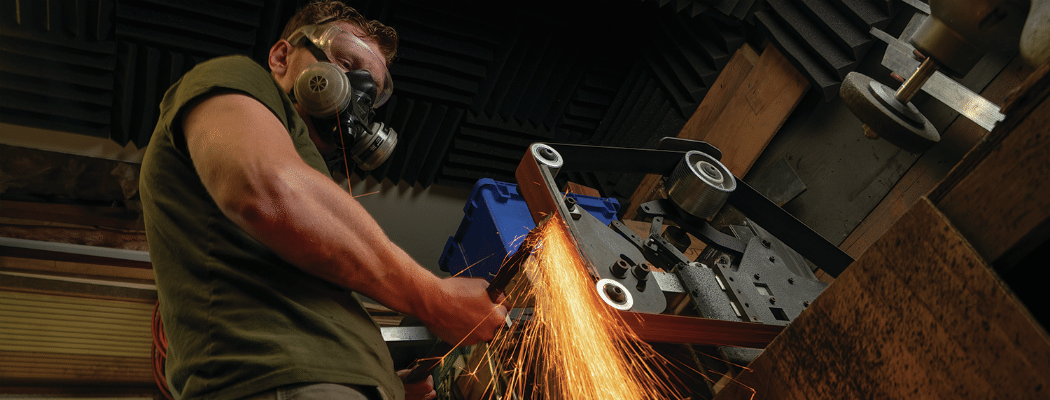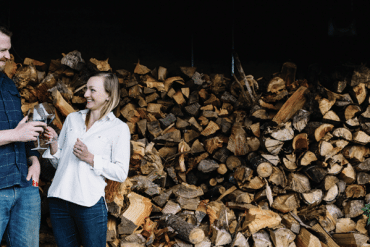How local blacksmith Keaton Goddard became a cut above the rest.
 Keaton Goddard—all six feet four inches—stood ramrod-straight behind an anvil on a dimly lit television set. Goddard and contestants Nic, Logan and Dale had just learned they had three hours to turn a high-carbon steel cylinder into a gracefully curving blade. Goddard knew a single false hammer blow could send him back to Nantucket empty-handed. At least ten years younger than two of the contestants, Goddard, twenty-five, completed bachelor’s and master’s degrees in chemical engineering at Worcester Polytechnic Institute in 2018. Last summer, he was pushing leaf blowers at Home Depot when he heard he’d been chosen to compete on the History Channel’s Forged in Fire.
Keaton Goddard—all six feet four inches—stood ramrod-straight behind an anvil on a dimly lit television set. Goddard and contestants Nic, Logan and Dale had just learned they had three hours to turn a high-carbon steel cylinder into a gracefully curving blade. Goddard knew a single false hammer blow could send him back to Nantucket empty-handed. At least ten years younger than two of the contestants, Goddard, twenty-five, completed bachelor’s and master’s degrees in chemical engineering at Worcester Polytechnic Institute in 2018. Last summer, he was pushing leaf blowers at Home Depot when he heard he’d been chosen to compete on the History Channel’s Forged in Fire.
Since his junior year in high school, Goddard has been forging hunks of metal into knives, swords and fanciful weapons. He has turned rusted truck springs from the junkyard into polished blades almost as tall as he is. When Goddard saw the Instagram message from a casting agent, he thought, There’s no way this is real. He’d heard that smiths spent years vying for a spot on Forged in Fire, now in its seventh season. He made the cut in a matter of months. So last July, he quit his job and moved back to his family home on Nantucket to prepare to test his bladesmithing skills before a national audience this summer.
 At a house off Somerset Road, he walked visitors through a basement shop outfitted with a belt grinder, a heat-treating oven, a milling machine and a lathe for finish work. Outside is an anvil and a forge fueled by propane. “Forging is dangerous,” Forged in Fire warns viewers at the beginning of each show, but Goddard routinely shoves hunks of metal into a 2,000-plus-degree inferno and then whacks them on an anvil, making sparks fly. His only injury was once nicking his finger on a sharp blade.
At a house off Somerset Road, he walked visitors through a basement shop outfitted with a belt grinder, a heat-treating oven, a milling machine and a lathe for finish work. Outside is an anvil and a forge fueled by propane. “Forging is dangerous,” Forged in Fire warns viewers at the beginning of each show, but Goddard routinely shoves hunks of metal into a 2,000-plus-degree inferno and then whacks them on an anvil, making sparks fly. His only injury was once nicking his finger on a sharp blade.
Even though Goddard knew being a sales rep for a power tool company wasn’t his true calling, he believed he’d likely move up from sales one day. But Forged in Fire presented an opportunity to follow his passion. He’d made his first knife after seeing a YouTube video where someone fashioned a knife out of a file. He went out and bought the wrong material at the Marine Home Center, but his high school shop teacher gave him a crash course on metallurgy. His engineering training in college filled in the rest.
 Goddard now has his own YouTube channel, Faraway Forge, with more than 250,000 subscribers. His videos show only his hands—bare or clad in scarred leather gloves—working on a blade. To be more accessible to non-English-speaking audiences, the videos have no spoken words, just the clank of hammer on metal. He’s not sure why, but his videos are particularly popular in Indonesia.
Goddard now has his own YouTube channel, Faraway Forge, with more than 250,000 subscribers. His videos show only his hands—bare or clad in scarred leather gloves—working on a blade. To be more accessible to non-English-speaking audiences, the videos have no spoken words, just the clank of hammer on metal. He’s not sure why, but his videos are particularly popular in Indonesia.
He doesn’t like to waste things. “It’s still amazingly useful,” Goddard says of a rusty bar that looks like detritus from a car accident. “You just have to know how to use it.” Then there’s the challenge of making something “really cool and badass” while condensing eighty hours of work into 13 minutes for YouTube. “Forging a katana from junk” has more than 13 million views. Goddard wants to make tools that somebody will love and that will last forever.
 In his shop, Goddard displays a rapier whose hilt is encircled in sprockets from a bicycle gear chain. It expresses tradition, craft and history, while its unexpected elements give it a modern vibe. His incarnation of a post-apocalyptic master sword from the Legend of Zelda video game is studded with teeth from repurposed gears; the hilt is wound with strips of leather. This kind of creativity and sharp design was what drew the Forged in Fire producers to this unknown smith from Nantucket.
In his shop, Goddard displays a rapier whose hilt is encircled in sprockets from a bicycle gear chain. It expresses tradition, craft and history, while its unexpected elements give it a modern vibe. His incarnation of a post-apocalyptic master sword from the Legend of Zelda video game is studded with teeth from repurposed gears; the hilt is wound with strips of leather. This kind of creativity and sharp design was what drew the Forged in Fire producers to this unknown smith from Nantucket.
Goddard’s appearance on Forged in Fire premiered this summer. Faced with the challenge of transforming a high-carbon steel cylinder into an elegant blade, the twenty-five-year-old bested his more experienced competitors. One of his opponent’s blade had developed cracks. Another contestant’s blade was the wrong shape. Meanwhile, Goddard’s blade lined up almost perfectly with the knife-shaped gap in the jigsaw puzzle the contestants had to match. He then spent two hours fixing flaws in his blade, carefully grinding out an ugly brown blotch and shaping a handle from mahogany. The effort sent Goddard and a contestant from Texas named Logan into the final round.
 Competing for the $10,000 grand prize, their challenge was to recreate a Japanese ono, a six-foot-long seventeenth-century samurai battle ax. For four days, a crew taped Goddard working on the weapon on Nantucket while another crew followed Logan to Texas. Returning to the studio with the weapons, the two axes would be judged on weight, balance and craftsmanship. Goddard’s blade was thin and finely honed, with brass details outlining heart-shaped cutouts on the body of the semi-circular steel blade. In one test, the axes were swung like baseball bats into a bamboo wall. “I wanted to go above and beyond, making it as light as possible while still strong and aesthetically pleasing,” Goddard said. Had he made the right tradeoffs? Goddard’s biggest fear was that the hickory handle would break and he’d lose by default. His ono showed more artistry, but his and Logan’s weapons were neck-and-neck in terms of performance.
Competing for the $10,000 grand prize, their challenge was to recreate a Japanese ono, a six-foot-long seventeenth-century samurai battle ax. For four days, a crew taped Goddard working on the weapon on Nantucket while another crew followed Logan to Texas. Returning to the studio with the weapons, the two axes would be judged on weight, balance and craftsmanship. Goddard’s blade was thin and finely honed, with brass details outlining heart-shaped cutouts on the body of the semi-circular steel blade. In one test, the axes were swung like baseball bats into a bamboo wall. “I wanted to go above and beyond, making it as light as possible while still strong and aesthetically pleasing,” Goddard said. Had he made the right tradeoffs? Goddard’s biggest fear was that the hickory handle would break and he’d lose by default. His ono showed more artistry, but his and Logan’s weapons were neck-and-neck in terms of performance.
Grunting with the effort, martial artist and judge Doug Marcaida stabbed and slashed Goddard’s double-headed ax at a male torso made out of ballistic gel. Fake blood sprayed and fake internal organs went flying. “Your edges were sharp and it dug in deep. Your ono was an ‘oh, yes,’” Marcaida told Goddard, before adding his signature catch phrase: “It will kill.” Looking a tad shell-shocked, Goddard said, “Thank you.”
 A few moments later, the judges congratulated Goddard, naming him the Forged in Fire champion. Goddard’s smile looked more like a grimace. “Are you in pain?” the host asked. The experience had been so nerve-wracking, it didn’t hit him until he was walking off the set that he’d actually won. In the months since the show was taped, he’s been working to capitalize on his newfound fame and connections in the blade-smithing community. With the help of social media, he hopes to build a client base for his fledgling business. Mostly, he’s happy to be back on Nantucket. The best part, he said, is being able to live on Nantucket with his family and turn his passion into a career.
A few moments later, the judges congratulated Goddard, naming him the Forged in Fire champion. Goddard’s smile looked more like a grimace. “Are you in pain?” the host asked. The experience had been so nerve-wracking, it didn’t hit him until he was walking off the set that he’d actually won. In the months since the show was taped, he’s been working to capitalize on his newfound fame and connections in the blade-smithing community. With the help of social media, he hopes to build a client base for his fledgling business. Mostly, he’s happy to be back on Nantucket. The best part, he said, is being able to live on Nantucket with his family and turn his passion into a career.








